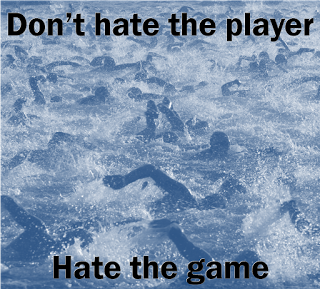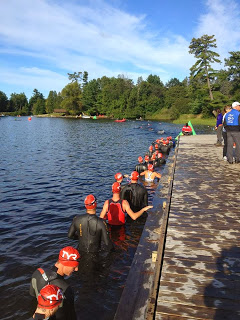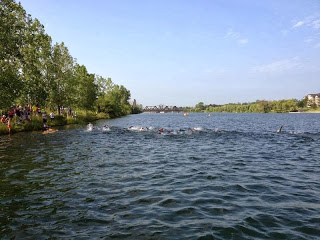The idea for this post came to me moments after the start of a triathlon, with a stroke of inspiration. As usual, I found myself fending off flailing fists, vicious kicks, and full-body groping that would put the most thorough airport security agent to shame. I finally managed to extricate myself from the the tangle of thrashing limbs with a long, lung-searing surge. A thought dimly registered through the anaerobic haze: I am one minute into a 70.3 mile race.
Triathletes learn early on that an evenly paced effort usually produces the best performance, at least in theory. In reality, many factors conspire to ruin the best laid pacing plans: hills, wind and, without fail, your fellow racers.
There is no better example than the swim start. Most triathletes start at a pace that is at best overoptimistic, and at worst, suicidal. If everyone started at their own sustainable pace, the field would quickly thin out and everyone would have a smooth, efficient and drama-free swim, setting themselves up for their best possible race performance. Instead, what could be a very civilized and orderly process inevitably degenerates into a dunking match.
I’m typically among the first swimmers out of the water at local races, but I’m often clawing and scrabbling for space well into the race. If I’m burning matches, I can’t imagine how much these two-minute-heroes must suffer later in the race!
Are people temporarily possessed by adrenaline-fueled Phelpsian delusions, or is going out hard a rational choice given the circumstances?

The Triathlete’s Dilemma
Among the patchwork of courses I cobbled together for my BSc was a course in game theory. Game theory is “the science of strategic reasoning” or more descriptively, it’s a math-y way to study how people (players) make decisions and interact in competitive situations (games). Its applications range from economics to psychology to getting lucky reproductive success.
The start of a triathlon is a game and every racer is a player. For simplicity, let’s assume that racers have three strategies to choose from: start at a reasonable pace (“even pacing”), go out hard (“sprint”) or hang back (“wait”). For good reason, beginners and weaker swimmers are advised to wait. This is the best strategy if your sole goal is to complete the race.
Let’s consider Joe Triathlete, a middle-of-the-pack racer whose aspirations go beyond simply finishing. He wants to have the best possible swim, finishing time and age group placing. That leaves Joe with two viable options: even pacing or sprint. Let’s get inside Joe’s head:
Even pacing: Joe knows that starting at a moderate, sustainable pace will best conserve his energy for the long race ahead. If everyone started at their ideal pace, there might be a little congestion at first, but the field would soon spread out and carnage would be kept to a minimum. On the other hand, if most swimmers sprint while Joe does not, he would get clobbered and would have to zigzag around slower swimmers as they run out of steam.
Sprint: Joe knows that sprinting takes a lot of energy and he will pay a price later in the race. At the same time, if his competitors start conservatively, a short sprint would allow him to escape the chaos and congestion with minimal effort and have an awesome swim. Tempting…
This “game” can be summarized by the payoff matrix below, which shows the possible swim start outcomes for Joe resulting from his decision (left column) and every other racers’ decisions (top row).

Joe recognizes that regardless of what everyone else decides, he is better off sprinting. If other people pace evenly, he can have his best possible start by sprinting. If everyone sprints, the most he can hope for is a bad start, but at least by sprinting he’ll avoid the worst possible outcome.Now imagine that every competitive triathlete has the exact same thought process as Joe. The result is that everyone always sprints and has a sub-optimal start! Think of it as mutually assured destruction, only in this case, “destruction” is not nuclear war but a subpar performance, a lungful of scuzzy water and a full-body frisk by a fat guy in spandex.
So it’s a hopeless situation?
I’d love to believe that swim starts could be tamed by appealing to common sense and decency. If we all cooperated by pacing evenly, we would all be better off! But I’m not holding my breath. On the start line at Muskoka 70.3, I asked the men around me to keep it clean. They all agreed. Two seconds after the start I was getting a dutch rub from the bruiser next to me.
There are other solutions. Smaller waves, self-seeded waves based on projected swim times and wider start lines can mitigate swim start chaos. So can time trial starts, but these create an entirely different racing experience and are impractical for large fields.


What can you do?
Like it or not, rough-and-tumble swim starts are here to stay. Here are a few ways you can skip the scrum:
1. Carefully choose your starting position. Swimmers tend to congregate around the point with the shortest line to the first turn. It’s a good idea to avoid this hot spot unless you are a swim stud. And if you line up on the front row, for everyone’s sake, please have the swim credentials to back it up!
2. Develop your top end speed and ability to recover quickly from anaerobic efforts. I include short sprint sets like these most practices:
- 10 × (25m free sprint, 25m back easy)
- 4-8 × 50m sprint with :30 recovery
- 75m repeats accelerating from easy pace to all-out sprint with :05 recovery
3. Master dolphin diving, a technique that many triathletes overlook for beach starts (and exits).







